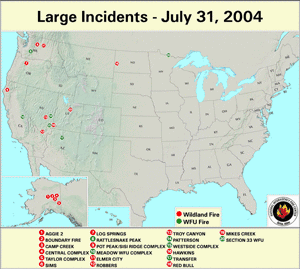According to the National Interagency Fire Center (NIFC), wildland fires in 2004 consumed over 5.4 million acres across the U.S. as of the end of July. Fire activity in Alaska increased dramatically during late June and early July, burning over 3.4 million acres by the end of the month. An additional 400,000 acres were blackened across the remainder of the contiguous U.S. in July.
The most significant of the large fire activity occurred in central and eastern Alaska (as well as in the adjacent Yukon Territory of Canada). Fire activity in the state decreased towards the end of July, as the region began to experience some much needed precipitation. However, the two largest fires in Alaska (the Taylor Highway Complex, and the Boundary Fire) continued to burn into August.
Since the fire activity broke out in mid–June, smoke emissions from the Alaskan fires have spread over Canada and the U.S. Long–range transport of smoke from the Alaskan fires has been observed as far east as the northeast coast of the U.S. and as far south as Louisiana and the Gulf of Mexico coast.
The Pacific Northwest also had several large fires during July, as areas east of the Cascade Mountains have experienced a significant increase in fire activity. Several large fires were also observed in southern California during the middle of the month.
Both short– and long–term drought conditions have continued to affect a large portion of the western U.S. The record and near–record dry conditions throughout the West have contributed to extremely low dead fuel moisture levels. As of the end of July, fine fuels remained very dry across the intermountain West and the Great Basin, with 10–hr fuel moistures only 1–2% from the High Plains to the Pacific Coast. Medium to larger fuels (i.e. 100–hr and 1000–hr) also continued to be extremely dry across the region, with 1000–hr fuels below 5% over most of California, the Great Basin, and the Columbia Plateau.
| As of July 31, 2004 | Nationwide Number of Fires | Nationwide Number of Acres Burned |
|---|---|---|
| 2004 | 47,650 | 5,495,416 |
| 2003 | 36,301 | 1,822,974 |
| 2002 | 53,070 | 4,258,849 |
| 10–year Average | 53,111 | 2,343,447 |
At the end of July, the Keetch–Byram Drought Index (KBDI), a widely used index for fire risk, had the largest potential for fire activity in the contiguous U.S. across California and the Pacific Northwest. Areas of the southern Plains also had increased potential for large fire development. In addition, most of the western U.S. had an increased potential for ignitions from lightning, with the Lightning Ignition Efficiency above 30% across a large region from the Cascades to the Rocky Mountains.
 NOAA's National Centers for Environmental Information
NOAA's National Centers for Environmental Information


